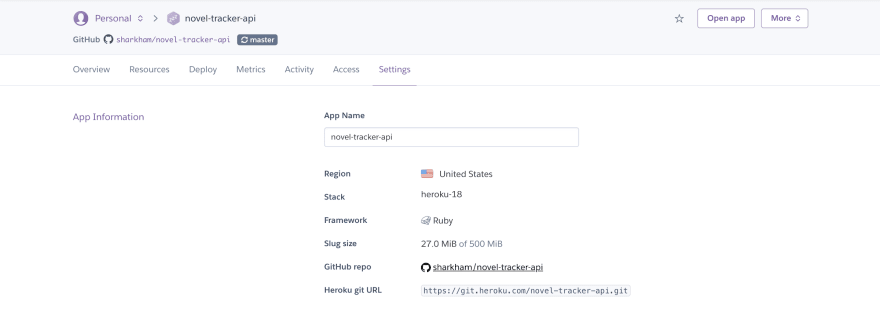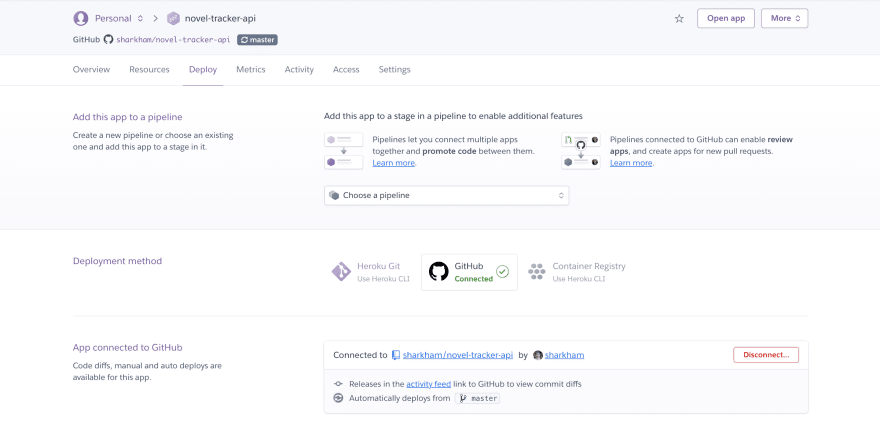(originally posted May 15, 2020)
My final Flatiron School project was made for use by an online novel contest, and after the project deadline, I set my own deadline of when I told the contest's organizer I would have the live website up by. This led to a lot of quick research and troubleshooting how to get a React/Rails app hosted, and another two weeks after submitting my final project, I had it up! The experience of seeing something I made in use has been very gratifying, and this blog post is an overview of what worked for me, in case it helps someone else!
Initial set-up
To start off, my app is built with React.js, Redux, and Rails 6. I built the front-end in a project-name-frontend folder with create-react-app and the backend in a project-name-backend with rails new project-name-api --api --database=postgresql. The frontend and backend are both hooked up to separate github repos. I'm also working off a Mac. This blog post will assume you have a similar setup in order for it to work as a tutorial!
To hook up your Rails backend to Heroku, it is important it use Postgres instead of SQLite3 (the default) as a database. Adding the --database=postgresql takes care of a lot of the set up within your Rails project if you include this when you're building it, but I found this article helpful too for getting Postgres installed on my machine. You can skip a few of the steps if you start your Rails project setting the database to Postgres, but the rest of it still applies.
Deploying the backend
Alright, so you've built your React/Rails project, you have a Postgres database in Rails, everything is working in development, you're ready to deploy!
The first step is getting your backend up on Heroku. Start by making an account on Heroku, and then navigate to this tutorial. It will prompt you to install the Heroku CLI, log in on the command line with heroku login, and then configure your config/database.yml file.
What is on the tutorial works for this, but there is a lot of text there, so for simplicity's sake, this is what worked for me:
default: &default
adapter: postgresql
encoding: unicode
username: <%= ENV['POSTGRES_USER'] %>
password: <%= ENV['POSTGRES_PASSWORD'] %>
pool: 5
timeout: 5000
host: <%= ENV['POSTGRES_HOST'] %>
development:
<<: *default
database: <%= ENV['POSTGRES_DEVELOPMENT_DB'] %>
test:
<<: *default
database: <%= ENV['POSTGRES_TEST_DB'] %>
production:
<<: *default
database: <%= ENV['POSTGRES_DB'] %>
Now, this relies on some environmental variables. You should have these in an .env file and that .env file added to your .gitignore so it won't show up when you push to github.
For example:
POSTGRES_USER='username'
POSTGRES_PASSWORD='password'
POSTGRES_HOST='localhost'
POSTGRES_DEVELOPMENT_DB='app_name_development_db'
POSTGRES_TEST_DB='app_name_test_db'
POSTGRES_DB='app_name_db'
Next, to deploy your app on Heroku, make sure you're in your project-name-backend directory and type heroku create. It should say something like:
Creating app... done, radiant-sierra-11874
https://radiant-sierra-11874.herokuapp.com/ | https://git.heroku.com/radiant-sierra-11874.git
(source)
Following along with the Heroku tutorial, you can check that the remote was added to your project correctly by typing git config --list | grep heroku. If you see fatal: not in a git directory you're not in the right directory.
Otherwise, type git push heroku master to deploy your code. This will give you a long block of text, including some warnings at the end you might want to debug.
If everything goes well there, you can migrate your database, and seed it if applicable:
heroku run rake db:migrate
heroku run rake db:seed
This is an abbreviated run through that pulls out the specific steps from Heroku's "Getting Started with Rails 6" article that worked for me, but I highly recommend the full article for more detail here.
If all of this is working, you can visit your Heroku dashboard to see your app.
In the settings tab, you can change the app's name:
And in the deploy tab, you can connect your app to your Github repo so pushing changes there will push changes to the live Heroku app as well:
Deploying the frontend
We'll get back to the backend later, but the next step to getting this app hooked up is deploying your React app through Netlify. It's possible to do the frontend through Heroku too of course, but I like Netlify for the frontend because it loads right away when you navigate to it. In the free version of Heroku, your server sleeps when it hasn't been pinged for a while, so hosting your frontend on Netlify will show your user the front page of your site right away while Heroku gets the backend up and running in the background. (With that said, I recommend using a fetch in componentDidMount on your React app's App.js component, or whatever else loads first, so that the Heroku server gets booted starting from when a user first gets to your site.)
To get started with Netlify, create an account then click to "New Site from Git". Clicking on "Github" from the list of options will let you search your Github repos for project-name-frontend. The settings on the next page are fine, you can go ahead and "Deploy site" from there. Netlify has a blog post with an overview of this process, featuring more screenshots, that I found helpful as well!
Once your Netlify app is up and running, you can change its name in the "General" section of settings, and then navigate to the "Build and Deploy" tab. Make sure the site is set up for continuous deployment, the first section there, and then scroll down to environment.
Set an environment variable with a key of something like this: REACT_APP_BASE_API_URL, and set the value to the URL of your new Heroku app.
The thing that I found when deploying my app is: running it on my local server in development, it uses environment variables from my .env file. Running it in production from Heroku and Netlify, the frontend and backend apps don't have access to any of these variables, so they have to be set through the Heroku and Netlify dashboards. This is actually great, because it's an easy way of making sure your frontend fetches from localhost:3000 (or whatever port your backend is on in) in development and from project-name-backend.heroku.app in production, but it takes some configuring.
In project-name-frontend, go into all of your files that make fetch requests. Change your base URL for these fetch requests to this:
const baseURL = process.env.REACT_APP_BASE_API_URL
In React apps, environment variables are accessed through process.env, and if you've made your app with create-react-app, all environment variables need to be prefaced by REACT_APP_ to work properly. (More information here!)
From here, make an .env.development file in your project-name-frontend directory, add it to your .gitignore file, and add this environment variable there:
REACT_APP_BASE_API_URL='http://localhost:3000/'
This should enable your frontend to properly fetch from your backend, from the local server in development and your heroku app in production!
But, there's a problem here--the backend doesn't know to accept requests from your Netlify frontend yet! We have to go back and do more configuration there.
A note about Netlify:
Before I go any further, I want to briefly mention that while Netlify loads faster than Heroku when first navigating to the live site, Netlify is definitely slower than Heroku to update after you've run git push and pushed changes through to it. I ran into a lot of issues debugging in deployment just because Netlify hadn't loaded the (working!) update I'd made to my code yet.
So if you are refreshing your Netlify frontend to see if something has worked, you might need to wait a few minutes for the update to take!
More backend configuration
Assuming your app was working in development before this, you should have your /config/initializers/cors.rb file configured. The cors file is where we tell the backend what requests to accept, so this is what needs to be reconfigured to get the Heroku app to accept fetch requests from the Netlify app.
Rails.application.config.middleware.insert_before 0, Rack::Cors do
allow do
origins ENV['FRONT_END_URL']
resource '*',
headers: :any,
methods: [:get, :post, :put, :patch, :delete, :options, :head],
credentials: true
end
end
Setting the cors file to allow origins ENV['FRONT_END_URL'] means it will allow requests from whatever that environment variable is set to in .env in development, and whatever that environment variable is set to on Heroku in production.
Add this line to your .env file (assuming you've set your port to 3001 on the frontend like I did):
FRONT_END_URL='http://localhost:3001'
On the Heroku dashboard, go into settings, down to Config Vars, and create a new FRONT_END_URL config variable and set it to your Netlify app URL.
Remember, modifications to the cors.rb file mean you need to restart your Rails server on the backend, and also, the change may take a minute or two to take effect in your Heroku app file too.
But, this is it! Both apps have been deployed, and should be working properly!
The Redux issue
Or, so I thought until I proudly sent the link to my website to the novel contest's organizer only to hear my beautiful app was only showing a blank page. Some poking around on my end trying to pull up the app in different browsers revealed I had the same problem too: the app was only displaying properly in Chrome.
Eventually I figured it out: Redux Devtools, which were amazingly helpful while putting together my app, somehow meant that the app wasn't visible for any browser that did not have the devtools installed. I'm sure there's a way of configuring this so the devtools are included in development and not in production, but facing a deadline, I just removed them and everything worked fine.
My code for creating my Redux store went from this:
const store = createStore(rootReducer, compose(applyMiddleware(thunk), window.__REDUX_DEVTOOLS_EXTENSION__ && window.__REDUX_DEVTOOLS_EXTENSION__()))
to this:
const store = createStore(rootReducer, applyMiddleware(thunk))
And everything worked!
I hope this is helpful to anyone else looking to deploy React/Rails apps!




Top comments (8)
I just deployed my app. I get the frontend showed up, but when I log in or sign up it didn't worked.
Hey Huy, congrats on getting the frontend of your app up, and sorry you've run into issues with the backend!
The biggest issue I ran into when I was deploying was that Heroku takes a little while to load, so when I logged in/signed up it would take a few for my database to boot up and actually process this.
How is your login/signup not working? Is your backend deployed to Heroku alright, and can you navigate to some of your JSON endpoints there to check it's working? (e.g. [back-end-url]/api/v1/trainers/1, that sort of thing?)
Do I just only need to run the app by using "wow-frontend.netlify.app"? Here are my REACT_APP_BASE_API_URL = wow-backend-api.herokuapp.com and FRONT_END_URL = wow-frontend.netlify.app. Are they correct? I can see my characters from wow-backend-api.herokuapp.com/api/....
Those look correct for your URLs, and both of those sites look like they're running! For the URLs, I would double check that this is exactly the path you were using in the development/local version of the app, like, if your API url in the frontend used to be "localhost:3000/api/v1" make sure your API url in production is "your-domain.herokuapp.com/api/v1" etc.
Hi Sam,
wow-backend-api.herokuapp.com/api/... is showed users data in the seed file.
and localhost:3000/api/v1/players is showed the recent users data which are stored in pgAdmin.
Example: Here is my fetchPlayer.js from frontend
const apiURL = process.env.REACT_APP_BASE_API_URL
export function fetchPlayers() {
return (dispatch) => {
fetch(
${apiURL}/api/v1/players) //Inlinecodehasback-ticks aroundit..then(resp => resp.json())
.then(players => dispatch({
type: 'FETCH_PLAYERS', payload: players
}))
}
}
Thanks,
I've a question. Does Heroku provides database as well?
It does, yes! I think it's automatically created during the
heroku createstep, and I found a stack overflow article about how to access it here. (I know there's a way to access it in the rails console from the command line too using the heroku CLI but I can't find those commands right now!)Extremely helpful. I always wondered how MongoDB had Atlas but how do we go about other services. Thank you